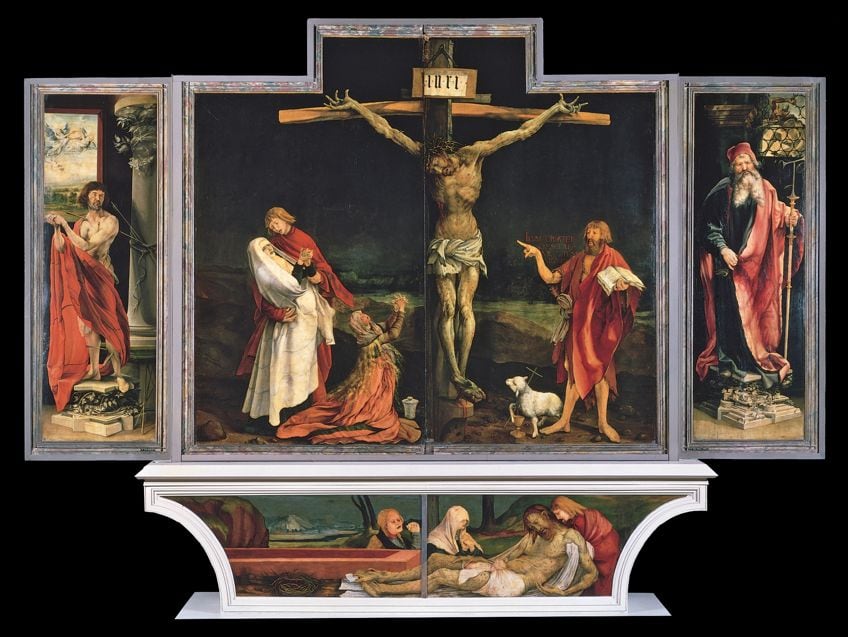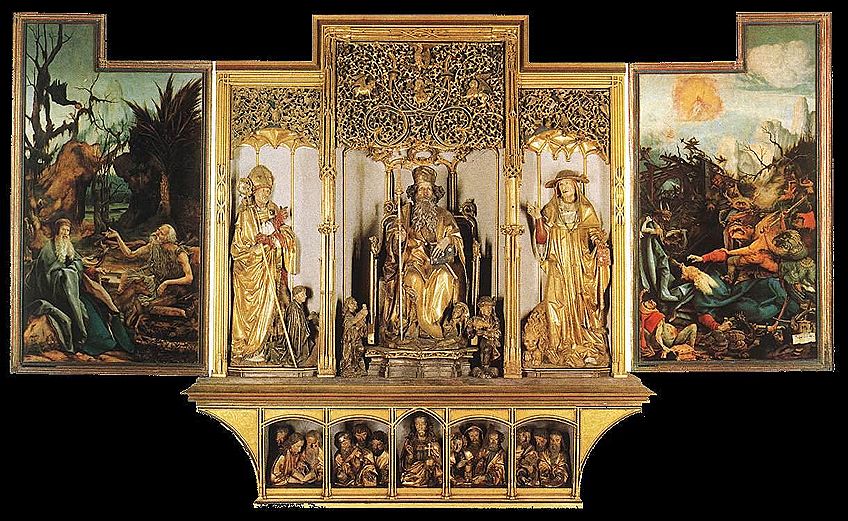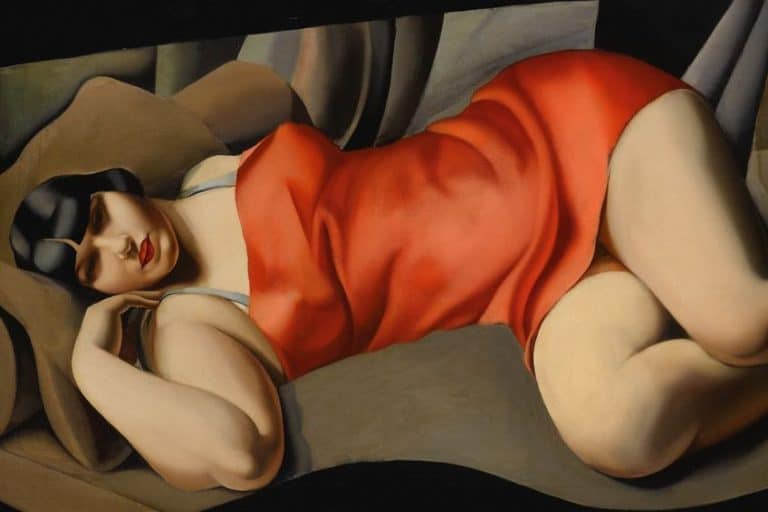“Isenheim Altarpiece” by Matthias Grunewald – A Deep Look
Altarpieces during the Medieval and Renaissance periods functioned as altar decorations in churches and ranged from paintings to sculptures, but they also held deeper devotional meanings. One of which includes the Isenheim Altarpiece (c. 1512 – 1516), a true gem from the German Renaissance period, which this article will explore in more detail.
Artist Abstract: Who Was Matthias Grünewald?
Mathias Grünewald was born in Würzburg in Germany; his exact date of birth is uncertain, but it has been estimated to be between 1475 to 1480, and his death was dated August 31, 1528, in Halle, in Germany. There is also uncertainty regarding his education and artistic training, and many sources have mentioned that he was written about by the artist and historian Joachim von Sandrart. Some of his artworks include The Mocking of Christ (1503), Stuppach Madonna (1514 – 1519), and Christ Carrying the Cross (1523 – 1524).

Isenheim Altarpiece (c. 1512 – 1516) by Matthias Grünewald in Context
The Isenheim Altarpiece is multi-layered and can be quite confusing when you first start looking at it, trying to make sense of its layout. Below we will simplify this German Renaissance polyptych (that simply means it has over three panels) composed of some paint, and some sculpted, parts. We will start with a contextual analysis of why it was created with a follow-on formal analysis briefly discussing the subject matter from the various panels.
| Artist | Matthias Grünewald |
| Date Painted | c. 1512 – 1516 |
| Medium | Oil and tempera on limewood (polyptych) |
| Genre | Religious painting |
| Period / Movement | German Renaissance |
| Dimensions (cm) | The measurements for the front panel have been stated as 269 x 307 (central), 232 x 75 (left and right panels), 76 x 340 (predella) |
| Series / Versions | N/A |
| Where Is It Housed? | Musée Unterlinden, Colmar, France |
| What It Is Worth | N/A |
Contextual Analysis: A Brief Socio-Historical Overview
An interesting point to note is that you might come by two names when researching the Isenheim Altarpiece, thus leading you to probably wonder, so who created the Isenheim Altarpiece? It was in fact created by two artists, namely Matthias Grünewald and Nikolaus of Haguenau, of which the former was the painter, and the latter was the sculptor of the back panel.
It is also important to note that we will focus on Matthias Grünewald’s paintings for the purpose of this article, but it will not be to the exclusion of the sculptures by Nikolaus of Haguenau who was reportedly a prestigious sculptor of his time, also believed to have created several sculptures for the Strasbourg Cathedral in France, of which some are reported as lost.
The Isenheim Altarpiece was created for Saint Anthony’s Monastery (following the Antonite Order), in Isenheim, in Alsace in France. It was commissioned by Guy Guers, who was the preceptor there reportedly from 1490 to 1516. The monastery was a hospital that cared for those who had Saint Anthony’s Fire, or Egotism, a disease that originated from a fungus found in rye and was reportedly widespread during the Medieval period.
The Isenheim Altarpiece acted as a source of solace for those who were being treated by the monks and furthermore the way Grünewald depicted the subject matter, specifically Jesus Christ who appeared in a heightened sense of suffering.
It undoubtedly would have created a relatability to the inflicted, which may have slightly eased their suffering as specifically seen in the Crucifixion from the Isenheim Altarpiece.
Formal Analysis: A Brief Compositional Overview
The formal analysis below will discuss the three painted panels from the Isenheim Altarpiece by Matthias Grünewald, briefly outlining them and looking at Grünewald’s artistic techniques according to the art elements and principles with a more specific focus on the Crucifixion from the Isenheim Altarpiece.

Subject Matter: Visual Description
Below, we will provide short visual descriptions of the Isenheim Altarpiece according to its viewing order and structural layout (consisting of three layers), which will be described as namely the front (first), middle (second), and back (third) panels or layers for better understanding.
Front Panel
The front, or first, panel, consists of four paintings. Starting with the left panel painting, it depicts St. Sebastian, who has an arrow through his right (our left) clavicle bone area and two arrows through his left (our right) calf muscles.
Other flesh wounds are noticeable on St. Sebastian’s chest and abdominal area, and what appears to be three loose arrows on the floor to his left (our right) and one held in place by a robe around the column behind him.
The right-panel painting depicts St. Anthony and a demon in the upper right corner, the latter appears to be breaking the window to come inside to accost St. Anthony, who is none other than the patron saint of the Isenheim monastery and known for being tempted by the devil.
The Crucifixion from the Isenheim Altarpiece is the central painting, portraying Jesus Christ on the cross with three figures to his right (our left), namely Mother Mary, the Apostle John, and Mary Magdalene who is on her knees with her arms raised and clasped hands looking up at the emaciated figure of Jesus Christ.

To the left (our right) is John the Baptist holding a book in his left hand (our right). There is also a small white lamb at his feet with a chalice and a cross, which has been widely described as symbolizing Jesus’ sacrifice. The bottom panel, also known as the predella, depicts Jesus Christ after he was removed from the cross with three figures around him, one is cradling his shoulders, partially propping him up. This is known as the Lamentation scene.
Middle Panel
If we look at the middle panel, or the so-called second view, the left panel or wing depicts what is known as the Annunciation, which takes place in a church setting. Here the Virgin Mary is on the left, appearing to be seated with a book in front of her, her hands are lightly held together, and her head is tilted to her right (towards us, the viewers) as if she has seemingly been startled by the appearance of Archangel Gabriel in front of her, to the right of the composition.
This is the moment when Mary is given the news that she will birth Jesus Christ.
The two central images depict a group of angels playing to the left and Mother Mary holding the baby Jesus Christ up in her arms, lovingly staring at him. There are other items around the composition that have been viewed as symbolic, for example, the bed, the washing container, and the chamber pot have been described as depicting Jesus’s mortality, and the rose bush and fig tree are described as pointing to Mother Mary’s innocence and virginity.

The right panel is a portrayal of the Resurrection, depicting Jesus Christ in a risen state with both arms and hands held up, revealing his stigmata on his palms. There is a large round orb of light behind him. There are several men lying on the floor, undoubtedly taken aback by Christ that has just risen from his tomb. Interestingly, this image has also been described as a source of “hope” for those who viewed it and symbolic of the idea that they could also overcome their afflictions.
Back Panel
The back panel, or third view, of the Isenheim Altarpiece, consists of the two painted left and right wings and the sculptures in the center are by Nikolaus of Haguenau. The left painting depicts Saint Paul and Saint Anthony in the desert, and the right panel depicts the temptation of Saint Anthony, a more grotesque depiction of what appears to be different demons. The central sculptures depict three larger figures, namely, to the left is Saint Jerome and to the right is Saint Augustine. There are also smaller figures and animals next to each of these three figures.
The lower panel, which is the predella, consists of five divisions, the central one depicts the figure of Jesus Christ and the other four (two on each side of Christ’s figure) depict the apostles, who are in threes.

Color
Matthias Grünewald was known for his use of luminous colors and if we look more specifically at the Crucifixion from the Isenheim Altarpiece, there is a contrast between dark and light colors. This heightens the scene’s dramatic effect, for example, the background is dark and almost a lifeless and neutral space emphasizing the subject matter in the foreground.

Furthermore, the background also appears darker near the top and becomes lighter as it nears the bottom. Grünewald’s color palette is limited to dominantly whites and reds of the clothes and robes, browns of the rocks and ground, and flesh tones.
Texture
Grünewald applied a naturalistic texture to the subject matter in the Crucifixion from the Isenheim Altarpiece, for example, the softer folds of the figures’ robes, which contrasts with the rougher surface seen on the rocks in the background. Notably, Christ’s body appears emaciated and stricken with wounds and his entire body appears mottled.
If we look at the physical texture of the paint, some areas appear smoother in application than others, for example, the smooth brushstrokes on the figures’ robes and the looser brushstrokes for the rocks in the background.

Shape and Form
There are naturalistic shapes and forms in the Crucifixion from the Isenheim Altarpiece, in other words, organic forms that follow the forms we see in real life. This is also contrasted with the more geometric shape of the altarpiece’s frames, which vary in squares and rectangles.

Line
Grünewald delineated the subject matter with clear outlines, which further emphasizes the foreground against the background. There are also a variety of lines in the composition, for example, the vertical lines created from the altarpiece’s framework as well as the vertical line implied from Christ’s body and the cross, including the standing figures around him. There is also a horizontal line created from the cross and the positioning of Christ’s arms creates diagonal lines.
There are also a variety of curved lines throughout the Crucifixion from the Isenheim Altarpiece.

Space
Grünewald depicted an empty space in the background of the Crucifixion from the Isenheim Altarpiece, which emphasizes what is taking place in the foreground. There is also a sense of depth created through other art elements like color and contrast of light and dark.

A Commission Made to Comfort
In this article, we discussed the Isenheim Altarpiece, a German Renaissance polyptych, created from around 1512 to 1516. It was one of Matthias Grünewald’s most popular and affecting works of art, portraying various painted Biblical narratives like the Crucifixion, the Lamentation, the Annunciation, and more, also consisting of sculptures done by Nikolaus of Haguenau.
Both contributing artists were German and worked during the Renaissance period, however, Grünewald was known for not following the “classical” tenets so characteristic of the Renaissance period. He depicted compositions that tended towards the Medieval and Gothic styles and his art has also been described as having “mystical” qualities.
The Crucifixion from the “Isenheim Altarpiece” is a poignant rendition of Jesus Christ on the cross. His body was torn and tattered, a bruised and battered icon for those who equally felt pinned by their own physical pain, being treated at the monastery for Ergotism, but nonetheless, a commission made to comfort.
Take a look at our Isenheim Altarpiece webstory here!
Frequently Asked Questions
Who Created the Isenheim Altarpiece?
The Isenheim Altarpiece (c. 1512 – 1516) was a joint project between the German Renaissance artists Matthias Grünewald and Nikolaus of Haguenau, the former a painter and the latter a sculptor. Their artwork followed the Medieval art styles.
Where Is the Isenheim Altarpiece Located?
The Isenheim Altarpiece (c. 1512 – 1516) by Matthias Grünewald and Nikolaus of Haguenau has been housed at the Musée Unterlinden in Colmar, France, reportedly since 1852.
Why Was the Isenheim Altarpiece Created?
The Isenheim Altarpiece (c. 1512 – 1516) by Matthias Grünewald and Nikolaus of Haguenau was created as a commission by Guy Guers from the Saint Anthony’s Monastery. This was also a hospital, in Isenheim, in Alsace, France, and acted as a visual balm for the patients who were being treated for Ergotism.
Alicia du Plessis is a multidisciplinary writer. She completed her Bachelor of Arts degree, majoring in Art History and Classical Civilization, as well as two Honors, namely, in Art History and Education and Development, at the University of KwaZulu-Natal, South Africa. For her main Honors project in Art History, she explored perceptions of the San Bushmen’s identity and the concept of the “Other”. She has also looked at the use of photography in art and how it has been used to portray people’s lives.
Alicia’s other areas of interest in Art History include the process of writing about Art History and how to analyze paintings. Some of her favorite art movements include Impressionism and German Expressionism. She is yet to complete her Masters in Art History (she would like to do this abroad in Europe) having given it some time to first develop more professional experience with the interest to one day lecture it too.
Alicia has been working for artincontext.com since 2021 as an author and art history expert. She has specialized in painting analysis and is covering most of our painting analysis.
Learn more about Alicia du Plessis and the Art in Context Team.
Cite this Article
Alicia, du Plessis, ““Isenheim Altarpiece” by Matthias Grunewald – A Deep Look.” Art in Context. February 8, 2023. URL: https://artincontext.org/isenheim-altarpiece-by-matthias-grunewald/
du Plessis, A. (2023, 8 February). “Isenheim Altarpiece” by Matthias Grunewald – A Deep Look. Art in Context. https://artincontext.org/isenheim-altarpiece-by-matthias-grunewald/
du Plessis, Alicia. ““Isenheim Altarpiece” by Matthias Grunewald – A Deep Look.” Art in Context, February 8, 2023. https://artincontext.org/isenheim-altarpiece-by-matthias-grunewald/.











